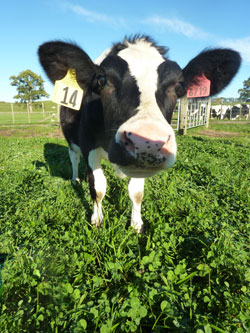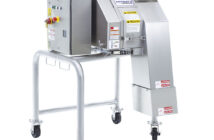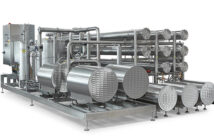By Steve Best
Scientists at AgResearch’s Ruakura campus have bred a cow that has produced a high protein milk that may be hypo-allergenic. Led by Dr Goetz Laible the team’s research has been published in the latest issue of the American science journal Proceedings of the National Academy of Sciences (PNAS), a feat described as “tremendously significant” by AgResearch chief executive Dr Tom Richardson.
“PNAS is one of the top journals in the world, and to be published in it reflects the world-leading quality of the science behind this discovery. This will be one of the top-ranking science publications from New Zealand this year,” Dr Richardson says.
The objective of the research was to ascertain whether it was possible to produce less of an allergenic milk protein.
“We were successful in greatly reducing the amount of beta-lactoglobulin (BLG), a milk whey protein which is not in human breast milk and which can cause allergic reactions,” says Dr Stefan Wagner, one of the lead authors on the paper.
“Two to three percent of infants are allergic to cow’s milk, and BLG allergies make up a large part of that percentage.
“The project started in 2006, we worked firstly in cell culture, moved on to the mouse model and then the cloning process, approximately two and half years ago. We could have worked with cow models but it is expensive to produce genetically engineered cows, so we decided to first test molecules that block the production of proteins in mice. We wanted to know it actually worked in animals. We were very successful in trials, so we comfortable to do that in cows.”
The scientists first tested the process in a mouse model engineered to produce the sheep form of BLG protein in mouse milk. Employing a technique called RNA interference, two micro RNAs (short ribonucleic acid molecules) were then introduced into the mouse to knock-down the expression of the sheep BLG protein. This resulted in a 96 percent reduction in the sheep BLG protein in mouse milk.
The next step in the process was to genetically create a female calf (Daisy) that could express the same two micro RNAs to target the BLG protein that is a normal part of cow’s milk. By hormonally inducing lactation the scientists were able to deduce that the collected milk had no detectable BLG protein.
A surprising further discovery was the high level of casein proteins – almost twice the normal level in cow’s milk.
“We didn’t have that expectation at all,” Dr Wagner says. “We were surprised we saw such a great increase in caseins.
“To avoid the delay of two years before a natural lactation, the milk we analysed was from an induced lactation. We only obtained small quantities over a few days for these initial studies. We now want to breed from Daisy and determine the milk composition and yield from a natural lactation.”
Dr Wagner says the research and the results are to the credit of the work of a larger team at AgResearch than just the authors of the published paper.
“There are a lot of other people involved and we wouldn’t Dr Stefan Wagner be where we are today without them,” he says.
“The work was very very interesting. It is such an enigmatic protein. Nobody knows what its function is. Humans don’t produce it, nor do rodents but it is produced in most mammalian species. There is a lot of speculation and we should now be able to shed more light on its function,” Dr Wagner says.
“This outstanding breakthrough has enormous implications due to its potential to reduce the significant impact milk allergies have on our children and neatly avoids the concerns associated with genetic modification of the milk proteins themselves,” Malaghan Institute Director Prof. Graham le Gros says.
The research team comprised coauthors Anower Jabed, Stefan Wagner, Judi McCracken, David Wells and Goetz Laible. The work was funded by the New Zealand Ministry of Business, Innovation and Employment and AgResearch.





























































































